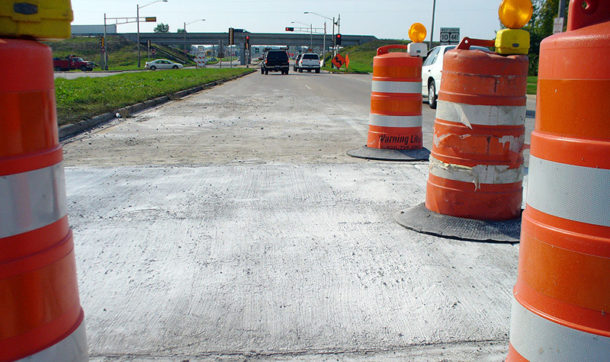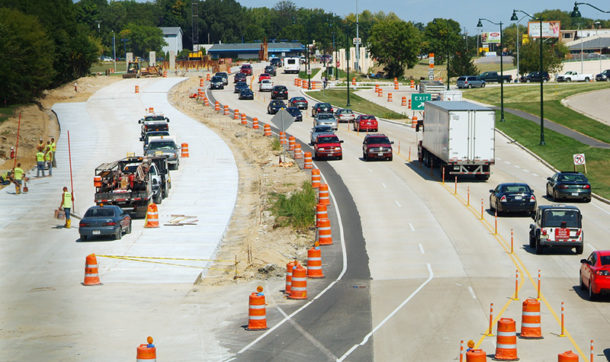Intelligent Transportation Systems Help Keep Drivers Safe in Work Zones
 Work zones bring more than just heavy traffic and headaches – they also bring hazards. Drivers must pay close attention in work zones to successfully drive through the complex array of signs, barrels, and lane shifts. Distracted driving (taking hands off the wheel, eyes off the road, or mind off the road) has contributed to an increase in work zone crashes in recent years. In 2015 a work zone crash occurred once every 5.4 minutes. On average in 2015, there were 12 work zone crashes each week that resulted in at least one fatality, as reported by the U.S. Department of Transportation Federal Highway Administration. In 2018 a highway work zone study conducted by the Associated General Contractors of America found there had been an 8% increase in work zone crashes since 2015.
Work zones bring more than just heavy traffic and headaches – they also bring hazards. Drivers must pay close attention in work zones to successfully drive through the complex array of signs, barrels, and lane shifts. Distracted driving (taking hands off the wheel, eyes off the road, or mind off the road) has contributed to an increase in work zone crashes in recent years. In 2015 a work zone crash occurred once every 5.4 minutes. On average in 2015, there were 12 work zone crashes each week that resulted in at least one fatality, as reported by the U.S. Department of Transportation Federal Highway Administration. In 2018 a highway work zone study conducted by the Associated General Contractors of America found there had been an 8% increase in work zone crashes since 2015.
Intelligent Transportation Systems (ITS) are being tested nationwide to help keep drivers safe in work zones. ITS techniques and methods help relieve congestion and improve road and transit safety. Specifically in work zones, ITS is helping to mitigate the effects of distracted driving through end-of-queue systems, dynamic merge systems, and the use of connected vehicles.
End-of-queue systems
End-of-queue crashes account for 26% of all traffic fatalities in work zones. End-of-queue (EOQ) warning systems are an effective way of reducing these crashes, which typically involve drivers rear-ending vehicles stopping or slowing ahead of them. EOQ systems use one or more sensors that are installed upstream of a work zone to provide a warning to approaching drivers of stopped or slowed traffic. The system may include static signs, detection devices, and dynamic message signs that provide enhanced information in seconds to drivers about traffic conditions, allowing them plenty of time to prepare and react.

Dynamic merge systems
Unlike the newer technology of EOQ systems, lane merge systems are one of oldest ITS systems used in work zones. There are two types of lane merge systems: early and late merging. Early merging encourages drivers to move out of the closed lane well before the forced merge point; late merging keeps drivers in their lanes until they reach the designated merge point, where they take turns merging into the single lane. Dynamic merging systems use message signs or flashing indicators to alternate between early and late merging, depending on real-time conditions.
Connected vehicles
Connected vehicles are one of the more innovative concepts for improving safety in work zones. The technology used in connected vehicles provides an opportunity to integrate roadside and vehicle data and messaging. These messaging systems include vehicle-to-vehicle, or V2V, communications, which will notify upstream travelers of the presence of a work zone, and vehicle-to-infrastructure communications, which involve interaction between a vehicle and fixed piece of the surrounding infrastructure, such as traffic signals.
States and other government entities are taking other actions to force drivers to focus on their driving. Many state Departments of Transportation have enacted campaigns against distracted driving. The Florida DOT, for example, recently developed the “Put It Down” Campaign to help drivers recognize the risks and consequences associated of texting and driving.
 Distracted driving can be anything that diverts a driver’s attention from the road. This includes eating, talking to passengers, adjusting the radio, applying makeup, reaching for objects in the vehicle, and most notably, cell phone use for calls and texting.
Distracted driving can be anything that diverts a driver’s attention from the road. This includes eating, talking to passengers, adjusting the radio, applying makeup, reaching for objects in the vehicle, and most notably, cell phone use for calls and texting.
More information is available in the National Safety Council’s white paper, “Understanding the Distracted Brain.” You can also learn more in our previous blog: “In a Work Zone? Hang Up the Phone.”
More information about Ayres Associates’ traffic engineering services is available here.

Post a comment: